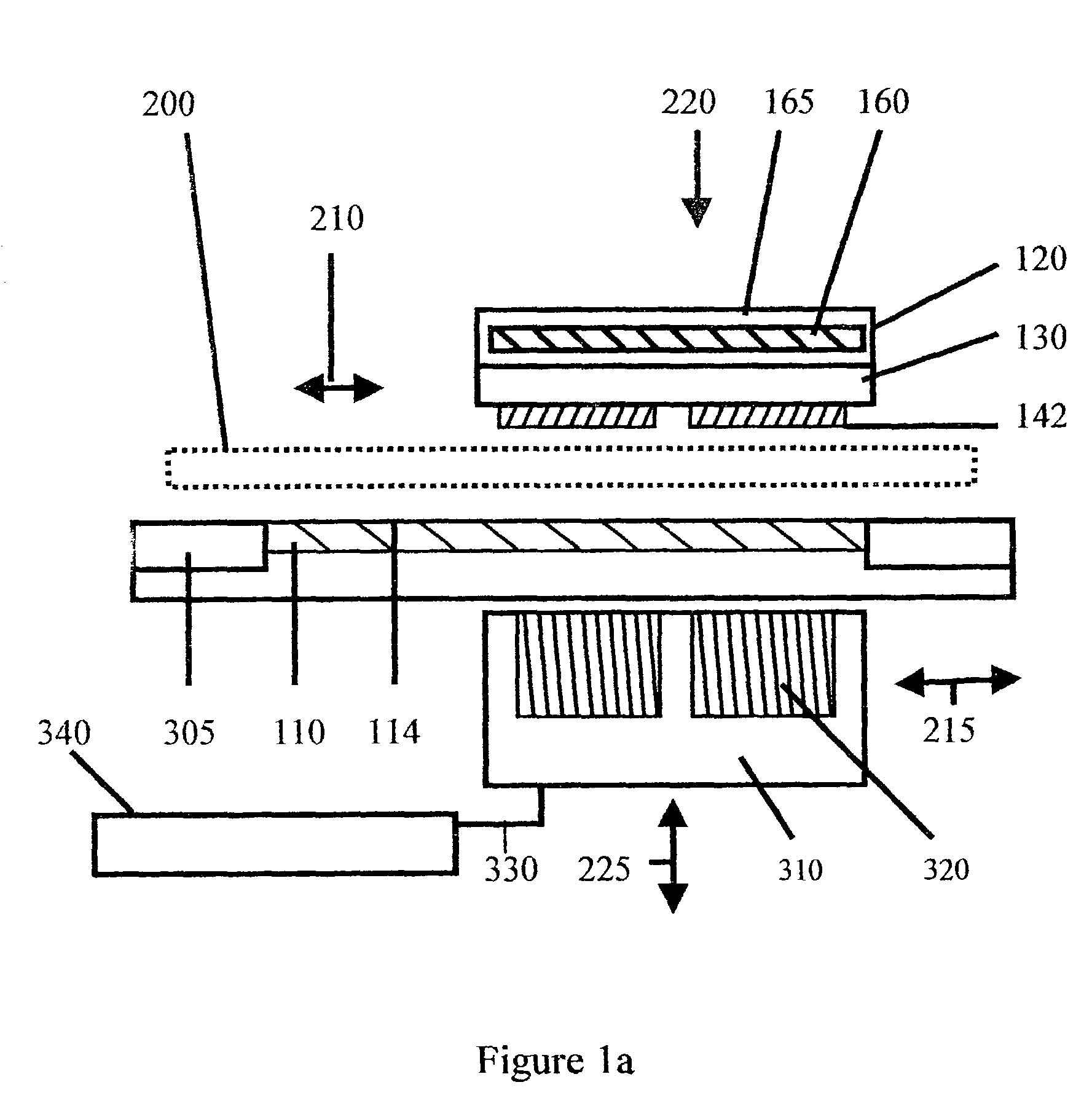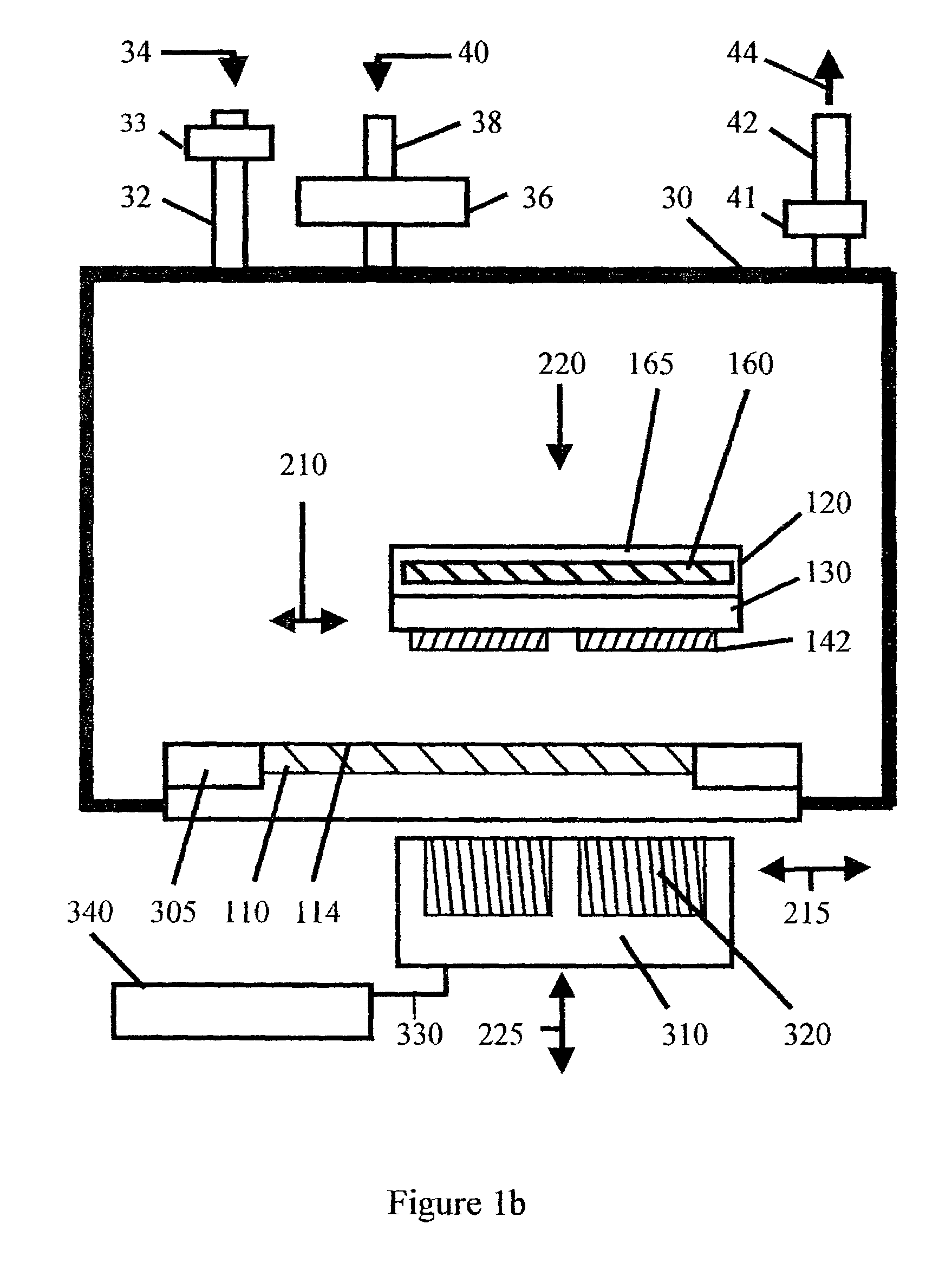[0010]It is an
advantage of this invention to improve the refining method for semiconductor wafer surfaces to make them as perfect as possible. It is an
advantage of this invention to make refining elements and refining equipment with a lower cost of manufacture and reduce the mechanical complexity of the refining equipment and thus also reduce the cost of refining a semiconductor wafer surface or workpiece surface. It is a preferred
advantage of preferred embodiments to develop refining apparatus and refining elements that can be smaller than the workpiece being refined. It is further an advantage of the invention to develop refining apparatus that are capable of supplying a parallel refining motion to refining elements through magnetic coupling forces. It is further a preferred advantage of the invention to develop current refining apparatus that are capable of supplying multiple different parallel refining motions to multiple different refining elements through magnetic coupling forces. It is further a preferred advantage of the invention to develop current refining apparatus that are capable of supplying a plurality of independent parallel refining motions to multiple different refining elements through magnetic coupling forces. It is further an advantage of the invention to develop current refining apparatus that are capable of supplying multiple different parallel refining motion to multiple different, independently controlled refining elements through magnetic coupling forces. It is further an advantage of the invention to develop current refining apparatus that are capable of supplying multiple different refining energies, actions, and / or parallel motions to multiple different, independently controlled refining elements. It is further a preferred advantage of the invention to develop current refining apparatus, refining elements, and refining capability that can add and remove material from the workpiece surface being refined. It is further a preferred advantage of the invention to develop current refining apparatus, refining elements, and refining capability that can add and remove material from the workpiece surface being refined using similar and / or identical drive elements. It is an advantage of the invention to develop a refining element which has a unique way of applying pressure to the unitary and / or a plurality of discrete refining surface(s) and to the workpiece surface being refined. It is an advantage of the invention to develop a refining element which has a unique way of applying refining energy or energies to the unitary and / or a plurality of discrete refining surface(s) and to the workpiece surface being finished. It is further an advantage of this invention to help improve yield and lower the cost of manufacture for refining of workpieces having extremely close tolerances such as semiconductor wafers.
[0011]A preferred embodiment of this invention is directed to a method for refining a workpiece having tracked information of the workpiece, the method comprising a step of providing a workpiece holder; a step of providing an operative control subsystem having at least one operative sensor, a controller, and a processor and wherein the processor has access to a cost of manufacture parameter and the tracked information of the workpiece; a step of applying a refining energy to the workpiece held in the workpiece holder; a step of sensing a progress of refining information with the at least one operative sensor during a period of non-
steady state refining; a step of determining a change for at least one
process control parameter using the cost of manufacture parameter, the tracked information of the workpiece, and the progress of refining information during the period of non-
steady state refining; and a step of changing the at least one
process control parameter to change the refining during the period of non-steady state refining.
[0012]A preferred embodiment of this invention is directed to a method for refining a workpiece having tracked information of the workpiece, the method comprising a step of providing a workpiece holder; a step of providing an operative control subsystem having at least one operative sensor, a controller, and a processor and wherein the processor has access to the tracked information of the workpiece, at least two cost of manufacture parameters, a process model, and historical performance; a step of applying a refining energy to the workpiece held in the workpiece holder during a refining
cycle time; a step of sensing the progress of refining information with the at least one operative sensor during a time period of non-steady state refining; a step of determining a change for at least one
process control parameter using the tracked information of the workpiece, the at least two cost of manufacture parameters, the process model, the historical performance, and the progress of refining information during the time period of non-steady state refining; and a step of changing the at least one process control parameter during the time period of non-steady state refining; and wherein the time period of non-steady state refining comprises at least a portion of the refining
cycle time.
[0013]A preferred embodiment of this invention is directed to a method for refining a workpiece having tracked information of the workpiece, the method comprising a step of providing an operative control subsystem having at least one operative sensor, a controller, and a processor and wherein the processor has access to the tracked information of the workpiece, at least two cost of manufacture parameters, a process model, a cost of manufacture model, and historical performance including a quantity of historical tracked information of prior workpieces; a step of applying a refining energy to the workpiece; a step of sensing the progress of refining information with the at least one operative sensor during a time period of non-steady state refining; a step of determining a change for at least one process control parameter using the tracked information of the workpiece, the at least two cost of manufacture parameters, the process model, the cost of manufacture model, and the historical performance including the quantity of historical tracked information of the prior workpieces, and the progress of refining information during the time period of non-steady state refining; and a step of changing the at least one process control parameter to change the refining during the time period of non-steady state refining.
[0014]A preferred embodiment of this invention is directed to a method of refining a workpiece having tracked information of the workpiece, the method of refining during a refining
cycle time comprising a step of providing a workpiece holder; a step of providing at least one operative control subsystem having at least one operative sensor, at least one processor, and at least one controller; a step of positioning the workpiece in the workpiece holder to
expose a workpiece surface for refining; a step of applying a refining energy to the workpiece surface; a step of sensing a progress of refining information with the at least one operative sensor during a time period of non-steady state refining; a step of sending the progress of the refining information to a processor having access the tracked information of the workpiece, at least two cost of manufacture parameters, a process model, a business model, historical performance including a quantity of historical tracked information of prior workpieces, and the progress of refining information during the time period of non-steady state refining; a step of determining a change for at least one process control parameter using the tracked information of the workpiece, the at least two cost of manufacture parameters, the process model, the business model, and the historical performance including the quantity of historical tracked information of the prior workpieces, and the progress of refining information during the time period of non-steady state refining; and a step of changing the at least one process control parameter during the refining cycle time during the time period of non-steady state refining.
[0015]A preferred embodiment of this invention is directed to a method of refining a workpiece having tracked information of the workpiece, the method of refining during a refining cycle time comprising a step of providing a workpiece holder; a step of providing at least one operative control subsystem having at least one operative sensor, at least one processor, and at least one controller; a step of positioning the workpiece in the workpiece holder to
expose a workpiece surface for refining; a step of applying at least two refining energies to the workpiece surface; a step of sensing a progress of refining information with the at least one operative sensor during a period of non-steady state refining; a step of sending the progress of the refining information to a processor having access to the tracked information of the workpiece, at least one cost of manufacture parameter, a historical performance including a quantity of tracked information, and the progress of refining information during the period of non-steady state refining; a step of determining a change for at least one process control parameter using the tracked information of the workpiece, the at least one cost of manufacture parameter, the historical performance including the quantity of tracked information, and the progress of refining information during the period of non-steady state refining; and a step of changing the at least one process control parameter during the refining cycle time during the period of non-steady state refining.
 Login to View More
Login to View More 


